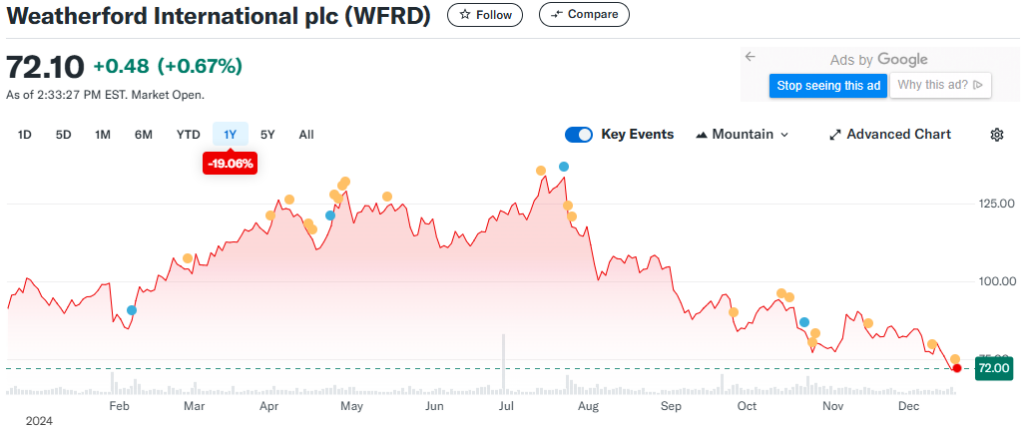Investing in the oilfield services sector can be both challenging and rewarding, given the industry’s dependence on global economic cycles, energy demand, and technological advancements. Weatherford International PLC, a prominent player in this space, offers an intriguing investment opportunity. This article delves into Weatherford’s business model, financial performance, industry position, and the factors investors should consider before making an investment decision.
Understanding Weatherford International PLC
Weatherford International PLC is a global oilfield services company that provides equipment and services for the drilling, evaluation, completion, production, and intervention of oil and natural gas wells. Headquartered in Houston, Texas, and incorporated in Ireland, Weatherford operates in over 75 countries and has a workforce of approximately 17,000 employees.
The company’s services span various segments, including well construction, well completion, and production optimization. Weatherford’s expertise in areas such as directional drilling, artificial lift systems, and well integrity solutions makes it a critical partner for exploration and production (E&P) companies seeking to optimize well performance and reduce operational risks.
Industry Overview
The oilfield services industry is closely tied to the upstream oil and gas sector. Factors such as crude oil prices, exploration budgets, and technological advancements significantly influence demand for oilfield services. After a prolonged downturn in the mid-2010s, the industry has been on a recovery trajectory, buoyed by stabilizing oil prices and increasing investment in unconventional resources like shale.
However, the sector remains susceptible to macroeconomic risks, geopolitical tensions, and environmental concerns. The transition toward renewable energy also poses a long-term challenge, necessitating strategic adaptations by companies like Weatherford to remain competitive.
Weatherford’s Strategic Position
1. Diversified Service Portfolio
One of Weatherford’s key strengths is its diversified portfolio of services and technologies. This diversification enables the company to cater to a wide range of client needs and reduce dependency on any single segment. For example:
- Drilling Services: Weatherford provides advanced directional drilling technologies that help clients achieve precise well trajectories and reduce drilling times.
- Artificial Lift Solutions: The company’s artificial lift systems enhance production from mature wells, a critical service in maximizing asset value.
- Digital Solutions: Weatherford’s digital offerings, such as ForeSite® and Centro™, leverage data analytics and machine learning to optimize well performance and reduce downtime.
2. Global Footprint
With operations in over 75 countries, Weatherford has a well-established global presence. This geographic diversity allows the company to capitalize on regional growth opportunities, mitigate political risks, and serve international oil companies (IOCs), national oil companies (NOCs), and independent operators.
3. Innovation and Technology
Weatherford’s focus on innovation is evident in its continuous investment in research and development. The company’s proprietary technologies, such as its Magnus™ rotary steerable system and Vero™ automated connection integrity system, are examples of its commitment to enhancing operational efficiency and safety for its clients.

Financial Performance
Weatherford’s financial journey has been marked by significant challenges, including a restructuring process following a Chapter 11 bankruptcy filing in 2019. Since emerging from bankruptcy, the company has made notable progress in strengthening its balance sheet and streamlining its operations.
Revenue Trends
Weatherford’s revenues are primarily driven by its core segments: Drilling and Evaluation, Well Construction, and Production and Intervention. While the COVID-19 pandemic led to a sharp decline in global drilling activity, the company has reported steady recovery in revenues, reflecting improved market conditions and increased demand for its services.
Profitability
Cost management has been a priority for Weatherford, especially following its restructuring. The company’s efforts to optimize its cost structure and improve operational efficiency have contributed to better margins. However, maintaining profitability remains a challenge due to the competitive nature of the industry and fluctuating oil prices.
Debt Management
Post-restructuring, Weatherford has focused on deleveraging and improving its liquidity position. The company’s reduced debt burden and enhanced financial discipline are positive indicators of its commitment to achieving long-term financial stability.
Key Investment Considerations
1. Market Recovery and Growth Prospects
Weatherford’s performance is closely tied to the health of the upstream oil and gas sector. With oil prices stabilizing and E&P budgets increasing, the demand for oilfield services is expected to grow. Weatherford’s diversified offerings and global presence position it well to capitalize on this recovery.
2. Competitive Landscape
The oilfield services market is highly competitive, with major players like Schlumberger, Halliburton, and Baker Hughes dominating the space. Weatherford’s ability to differentiate itself through innovative technologies and customer-centric solutions will be crucial in maintaining its market share.
3. Energy Transition
The global shift toward renewable energy and decarbonization poses both challenges and opportunities for Weatherford. While reduced reliance on fossil fuels may impact long-term demand, the company’s expertise in well optimization and energy efficiency solutions could play a role in supporting sustainable energy initiatives.
4. Geopolitical and Economic Risks
As a global company, Weatherford is exposed to risks such as geopolitical instability, regulatory changes, and currency fluctuations. Investors should closely monitor these factors, as they can impact the company’s operations and financial performance.
ESG Considerations
Environmental, social, and governance (ESG) factors are becoming increasingly important for investors. Weatherford has outlined its commitment to sustainability through initiatives aimed at reducing greenhouse gas emissions, enhancing workplace safety, and fostering diversity and inclusion. While the company has made progress, continued efforts in ESG reporting and goal-setting will be vital in meeting stakeholder expectations.
Valuation and Investment Outlook
1. Valuation Metrics
Investors should evaluate Weatherford’s valuation metrics, such as price-to-earnings (P/E) ratio, enterprise value-to-EBITDA (EV/EBITDA), and price-to-book (P/B) ratio, relative to its peers. Comparing these metrics can provide insights into whether the stock is undervalued or overvalued.
2. Dividend Policy
Weatherford does not currently pay dividends, reflecting its focus on reinvestment and debt reduction. While this may deter income-focused investors, it aligns with the company’s strategic priorities in the current phase of its recovery.
3. Analyst Ratings
Market analysts’ ratings and price targets can offer valuable perspectives on Weatherford’s investment potential. Investors should consider these assessments alongside their own analysis.
Conclusion
Weatherford International PLC presents a compelling case for investors seeking exposure to the oilfield services sector. The company’s diversified portfolio, global footprint, and focus on innovation position it well to navigate industry challenges and capitalize on growth opportunities. However, potential investors should remain cognizant of the risks, including market volatility, competitive pressures, and the energy transition.
For those with a high-risk tolerance and a long-term investment horizon, Weatherford could offer significant upside potential as the industry continues its recovery. Conducting thorough due diligence and staying informed about industry trends will be essential in making an informed investment decision.












